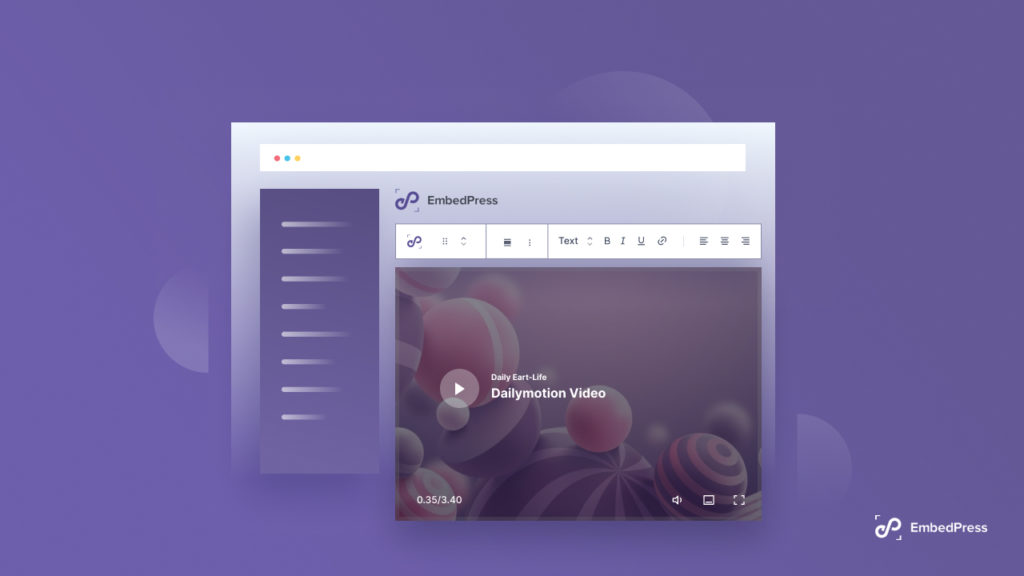Dailymotion has become a popular platform for both content creators and viewers alike. It's similar to YouTube but often includes a diverse range of videos that may not appear on other platforms. If you’re considering embedding Dailymotion videos on your website or blog, you’re in for a treat! Not only does it enhance your content, but it also offers numerous advantages that can elevate the user experience.
So, what makes Dailymotion a worthwhile addition to your website? Let’s break it down:
- Diverse Content: Dailymotion hosts an array of categories including music videos, news, sports, and user-generated content. This variety allows you to find videos that perfectly fit your niche.
- High-Quality Streaming: Users typically enjoy smooth playback, which is crucial for keeping visitors on your site longer. The platform supports HD quality, ensuring that your visitors get the best viewing experience.
- SEO Benefits: Embedding videos can boost your website's SEO. Search engines love video content, as it keeps visitors engaged, leading to better rankings.
- User Engagement: Videos tend to attract more attention than text alone. They can help increase user engagement, reduce bounce rates, and encourage visitors to spend more time on your site.
- Customization Options: Dailymotion offers various customization options so you can tailor the player’s appearance to fit your site’s design.
In summary, embedding Dailymotion videos can be a strategic way to enhance your website's content while reaping the benefits of increased user engagement and improved SEO.
How to Find the Embedding Option on Dailymotion

Now that you know why Dailymotion is a great choice, let’s dive into how you can actually find the embedding option. It's simpler than you might think, and in just a few steps, you can have engaging videos right on your website or blog.
Here's a step-by-step guide to locate the embedding feature:
- Search for a Video: Start by going to the Dailymotion website and using the search bar. Type in keywords related to the video content you are interested in.
- Select the Video: Click on the video that you want to embed. This will take you to the video’s dedicated page.
- Locate the Share Button: Below the video, you’ll see various options. Look for the “Share” button, which is usually represented by an arrow or shared icon.
- Choose the Embed Option: Click the Share button, and a pop-up will appear. In this pop-up, you’ll find the Embed code option. Selecting this will provide you with an HTML code snippet.
- Customize Your Embed Code: Dailymotion allows you to customize the video size by adjusting the width and height in the HTML code. Make sure to choose dimensions that fit well with your website layout!
- Copy the Embed Code: Once you’re satisfied with the settings, simply copy the embed code.
- Paste It on Your Website: Finally, head to your website or blog where you want the video to appear, and paste the embed code into the HTML section of your page.
And that’s it! You've successfully found and used the embedding option on Dailymotion. By following these straightforward steps, you're all set to enhance your website with engaging video content.
Also Read This: Ways to Prevent Ads on Dailymotion: Expert Tips
Steps to Embed a Dailymotion Video

Embedding a Dailymotion video on your website or blog is a straightforward process that can significantly enhance your content. Here’s a simple step-by-step guide to help you do just that:
- Find Your Video: First, you need to locate the Dailymotion video you wish to embed. You can do this by searching on the Dailymotion website or by using a direct link provided by the video creator.
- Click on the Share Button: Once you've found the video, look for the Share button below the video. Click on it, and you’ll see several options pop up.
- Select Embed: In the share options, choose the Embed option. This will bring up a box containing the HTML code you will need to copy.
- Adjust the Embed Code: You can customize the size of the video within this code. Look for the width and height parameters and adjust them to fit your site’s layout. You’ll want to make sure it looks good on both mobile and desktop versions!
- Copy the Code: After making your adjustments, copy the entire embed code provided. It should look something like this:
<iframe width="560" height="315" src="https://www.dailymotion.com/embed/video/your_video_id" frameborder="0" allowfullscreen></iframe>Paste the Code: Finally, go to your website or blog's HTML editor, paste the code where you want the video to appear, and save/ publish your changes. Voila! Your Dailymotion video is now embedded and ready for your audience to enjoy.
Also Read This: How to Apply BB Cream with Fingers: Achieve a Flawless Finish
Customizing Your Embedded Video Settings
Once you’ve embedded your Dailymotion video, you might want to customize its settings to better fit your website or blog. Here are some easy-to-follow options to consider:
- Adjust the Size: You can easily change the width and height attributes in the embed code to resize the video. A common practice is to make the video responsive by using percentages instead of fixed pixel values. For example:
<iframe style="width: 100%; height: auto;" src="https://www.dailymotion.com/embed/video/your_video_id"></iframe>?autoplay=1 to the video URL in the embed code. Just remember, autoplay might not be a good idea for all contexts!controls=0 (to hide) or controls=1 (to show) within the embed code.&loop=1 to the URL in the embed code.These customizations let you tailor the video experience to your audience’s needs. Remember, a well-embedded video can improve viewer engagement and provide more value to your content!
Also Read This: How to Create Stunning Teacher’s Day Cards with Creative DIY Ideas
Common Issues and Troubleshooting Tips
Embedding Dailymotion videos on your website or blog is generally a smooth process, but sometimes things can go awry. Let’s dive into the most common issues you might encounter along the way, along with some handy troubleshooting tips to set things right.
- Video Not Displaying: One common issue is when the embedded video doesn’t show up at all. This can happen due to incorrect embed codes. Double-check that you've copied the complete embed code directly from Dailymotion.
- Playback Problems: If your video plays but then stops suddenly, ensure that your internet connection is stable. A slow connection can cause buffering. Consider testing on different devices or browsers to narrow down the issue.
- Mobile Responsiveness: Sometimes, videos might not display correctly on mobile devices. Make sure you're using responsive embed codes. This way, your videos can adjust to different screen sizes.
- Content Restrictions: If the video content is blocked or restricted in certain regions, it may not play on your site. Stick to videos that don’t have geographical restrictions or user-set privacy limitations.
- JavaScript Conflicts: If the video interferes with other JavaScript on your site, inspect for any console errors. Sometimes, conflicts with other plugins or scripts can create problems.
By keeping these issues in mind and troubleshooting as needed, you can ensure that your Dailymotion videos enhance your website or blog rather than hinder it. It’s all about keeping an eye out for these common pitfalls and being ready to tackle them!
Conclusion and Final Thoughts
Embedding Dailymotion videos on your website or blog is a fantastic way to engage your audience and enrich your content. Not only do videos make your site visually appealing, but they also help convey information more effectively. As we've discussed, it’s a simple process of copying the embed code and placing it where you want the video to appear. However, remember that simple doesn't always mean problem-free.
While we've touched on some common problems and how to troubleshoot them, the key takeaway is to remain patient and resourceful. Here are a few final tips for ensuring a smooth embedding experience:
- Stay Updated: Always check for updates from Dailymotion regarding their embedding options and terms of service. This will help ensure you don’t run into compatibility issues.
- Test Your Setup: After embedding a video, take the time to preview your page. Confirm everything works as intended across various devices and browsers.
- Engage Your Audience: Encourage your viewers to watch, share, and comment on the videos you embed. Interaction can significantly boost engagement and drive more traffic to your site.
In the end, a well-implemented video can take your content to new heights. So don’t shy away from integrating multimedia; dive in and have fun with it! Happy embedding!
 admin
admin








